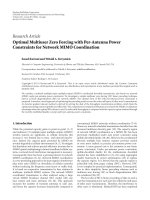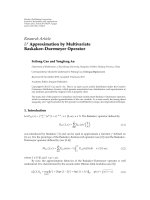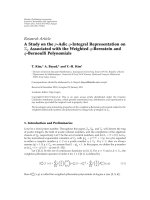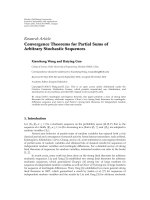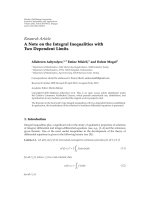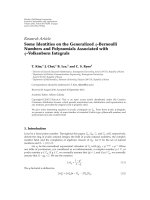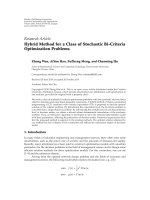Báo cáo hóa học: " Research Article Packet-Scheduling Algorithm by the Ratio of Transmit Power to the Transmission Bits in 3GPP LTE Downlink" pptx
Bạn đang xem bản rút gọn của tài liệu. Xem và tải ngay bản đầy đủ của tài liệu tại đây (848.99 KB, 8 trang )
Hindawi Publishing Corporation
EURASIP Journal on Wireless Communications and Networking
Volume 2010, Article ID 251281, 8 pages
doi:10.1155/2010/251281
Research Article
Packet-Scheduling Algorithm by the Ratio of Transmit Power to
the Transmission Bits in 3GPP LTE Downlink
Jungsup Song,
1
Gye-Tae Gil,
2
and Dong-Hoi Kim
1
1
School of Information Technology, Kangwon National University, 192-1 Hyoja-dong, Chuncheon 200-701, Republic of Korea
2
Central R&D Laboratory, Korea Telecom (KT), 463-1, Jeonmin-dong, Yuseong-gu, Daejeon 305-811, Republic of Korea
Correspondence should be addressed to Dong-Hoi Kim,
Received 22 February 2010; Accepted 13 July 2010
Academic Editor: Neal N. Xiong
Copyright © 2010 Jungsup Song et al. This is an open access article distributed under the Creative Commons Attribution License,
which permits unrestricted use, distribution, and reproduction in any medium, provided the original work is properly cited.
Packet scheduler plays the central role in determining the overall performance of the 3GPP long-term evolution (LTE) based
on packet-switching operation. In this paper, a novel minimum transmit power-based (MP) packet-scheduling algorithm is
proposed that can achieve power-efficient transmission to the UEs while providing both system throughput gain and fairness
improvement. The proposed algorithm is based on a new scheduling metric focusing on the ratio of the transmit power per bit
and allocates the physical resource block (PRB) to the UE that requires the least ratio of the transmit power per bit. Through
computer simulation, the performance of the proposed MP packet-scheduling algorithm is compared with the conventional
packet-scheduling algorithms by two primary criteria: fairness and throughput. The simulation results show that the proposed
algorithm outperforms the conventional algorithms in terms of the fairness and throughput.
1. Introduction
The 3GPP long-term evolution (LTE) standard, which is a
subset of the upgraded specifications of 3G network system,
aims at the goals such as peak data rate of 100 Mbps in
downlink and 50 Mbps in uplink, throughput increase at the
cell boundary, spectral efficiency improvement, and scalable
bandwidth [1–3]. As the 3GPP LTE was developed under
the assumption of a packet-switching operation, the packet
scheduler plays the central role in determining the overall
system performance.
Several packet schedulers, focusing on fairness and
throughput maximization, were introduced in [4–9]based
on the round robin (RR), proportional fair (PF), and
maximum throughput (MT) algorithms. To reduce the
complexity, most schedulers operate in two phases: time
domain packet scheduler (TDPS) followed by frequency
domain packet scheduler (FDPS) [4, 5]. The efficient FDPS
in [6] showed drastic increase in system throughput and
cell cov erage. In [7, 8], the authors proved significant
improvement of spectral efficiency in 3GPP LTE down-
link. Reference [9] showed that the PF algorithm pro-
vides fairness improvement but shows little decrease of
throughput. Packet scheduling algorithms for mixed traffic
system were also been proposed and evaluated in [10, 11],
but only the data rate was adopted in the scheduling
metric.
In this paper, we propose a novel minimum transmit
power-based (MP) packet scheduling algorithm that can
achieve power-efficient transmission to the UEs while pro-
viding both system throughput gain and fairness improve-
ment. The proposed algorithm is based on the ratio of the
transmit power to the number of transmission bits. Thus,
the proposed MP scheduler allocates the physical resource
block (PRB) to the UE that requires the least ratio of the
transmit power per bit. For this, it is assumed that the
channel quality indication (CQI) information for all UE
channels is available at the evolved Node B (eNB), with
which the modulation and coding scheme (MCS) level
and the UE transmit power are determined. The perfor-
mance of the proposed MP algorithm is compared with
the conventional algorithms through computer simulation,
considering real-time and non-real-time trafficinmulticell
environments.
The rest of this paper is organized as follows. Sec-
tions 2 and 3 briefly describe the packet-scheduling model
2 EURASIP Journal on Wireless Communications and Networking
L1
L2 level data buffer
Classifier
FDPS
TDPS
CQI
HARQ
QoS
Packet scheduler
Link adaptation
Figure 1: The structure of RT and NRT traffic packet scheduler in
eNB.
and algorithms, respectively. Section 4 explains the simula-
tion environment. The simulation results are discussed in
Section 5, and we conclude this paper in Section 6.
2. Packet Scheduling Models
The basic structure of downlink packet scheduler for RT and
NRT traffics in eNB of the 3GPP LTE is depicted in Figure 1.
The packet scheduler is divided into two phases: TDPS and
FDPS. In the TDPS, a small group of UEs are chosen as
the scheduling candidate set (SCS) based on diverse metrics:
buffer size, delay, CQI reports, and so forth. The TDPS does
not allocate PRBs to the UEs, but it conveys the information
of the UEs becoming scheduling candidates to the FDPS. In
the FDPS, the PRBs at Layer 1 are directly allocated to the
SCS received from the TDPS.
In a mixed traffic system, a classifier is necessary for the
efficiency of packet scheduling. The classifier sets indepen-
dent queues based on traffic types, and each queue i s given
its own priority. Thus, each traffic type can be independently
handled. With the classifier, the packet scheduler cooperates
with the CQI manager, hybrid automatic repeat request
(HARQ), link adaptation, and QoS manager. The link
adaptation decides a proper MCS level for respective UE
and PRB combinations based on the CQI which acts as
the primary criterion [12]. The PRBs with good channel
conditions are given a MCS level sending a lot of data [13].
The QoS manager checks UEs’ QoS requirements and the
packet scheduler calculates packet scheduling metrics.
2.1. Classifier. In Figure 1, the classifier classifies the mixed
trafficatLayer2databuffer according to the type of traffic.
Because each traffic type has its own QoS requirement, the
classifier is necessary in a mixed trafficsystemforefficient
packet scheduling. In this paper, we assume that RT and NRT
traffics exist at the same time. The classifier is provided with
traffic statements from L2 buffer and sets two independent
queues for RT and NRT traffics assigning different priorities
to the queues.
Under the consistent traffic environment, the most
efficient resource allocation scheme is divided into two
adaptations. First of all, voice streaming and WWW data
service exemplify RT and NRT tr afficinrealsystems.RT
traffics such as voice streaming have constant bit rate
(CBR) feature. Margin adaptation for OFDMA systems
[14] is considered as the most efficient resource allocation
scheme for power minimization of RT traffics. On the other
hand, NRT traffics like WWW data service have best effort
(BE) characteristic. Rate adaptation [14] is known as the
most efficient resource allocation scheme for throughput
maximization of NRT traffic with a power constraint.
Therefore, in order to maximize the system throughput
and to minimize the transmit power of mixed RT as well
as NRT traffi
cs at the same time, efficienttransmitpower
consumption becomes a key issue. Generally, RT traffics
need to deal with a delay constraint, so the higher priority
is essential [15]. Different priorities and power constraint
influence the PRB allocation during one transmission time
interval (TTI). Because the RT t raffic features a delay
constraint and CBR, the PRBs are firstly allocated to RT
traffic UEs. After PRB allocation for the RT traffic, the
NRT traffic UEs, having BE characteristic, consume the
remaining transmit power for PRB allocation, aiming at bit
rate maximization [15].
2.2. Time Domain Packet Scheduling. The main purpose of
the TDPS is to set the SCS. The TDPS does not directly
allocate the PRBs, but it restricts the number of UEs for the
FDPS to reduce the scheduling complexity. The SCS is chosen
based on a computed metric such as the CQI, throughput,
delay, and so forth. The SCS information is conveyed to
the FDPS and only the UEs restricted by the TDPS are
qualified as the FDPS candidates. The TDPS should concern
the data in L2 buffer and HARQ, simultaneously. When
retransmission is requested through HARQ, UEs requesting
HARQ are automatically comprised in the SCS.
2.3. Frequency Domain Packet Scheduling. In the FDPS
phase, the PRBs are directly allocated to the UEs and their
data are transmitted. It delivers the allocated data after
packet scheduling to physical level (L1) devices, and then
the L1 devices send the data by modulated signal through
physical channel. The FDPS considers only the SCS during
one TTI. The FDPS is completed when all transmit power
is consumed. A UE can load the information on the plural
PRBs, but a PRB cannot be shared by more than one UEs at
the same time.
3. Packet-Scheduling Algorithms
3.1. Conventional Packet-Scheduling Algorithms. Diverse
packet scheduling algorithms were introduced and their
performances were evaluated in terms of system throughput
and fairness [16–18]. For the best fairness, the RR algorithm
can be applied. In the RR algorithm, the scheduler at time
t uses the information on the elapsed time since the latest
EURASIP Journal on Wireless Communications and Networking 3
scheduled time (t
s
)foreachUEs as the scheduling metric
[10]: that is,
s = arg max
s
t − t
s
= arg min
s
t
s
,
(1)
where
s denotes the selected UE index. The MT algorithm
focuses on the spectral efficiency and achieves the best system
throughput. In 3GPP LTE system, data rate to be transmitted
is affected by the MCS level decided by the link adaptation
based on the CQI reported from the corresponding UE.
For the higher CQI, the link adaptation selects a higher
MCS level with more bits per symbol. The data rate D
s,n
is
calculated based on the recommended MCS level. Thus, the
MT scheduler is expressed as
(
s, n
)
= arg max
s,n
D
s,n
= arg max
s,n
Q
s,n
,
(2)
where
n is the index of the selected PRB, and Q
s,n
denotes the
CQI of the PRB n reported from the UE s. In other word, the
UE with the highest data rate acquires the highest priority.
The PF algorithm was introduced to solve monopolized
situation in the MT algorithm. Scheduling metric is defined
as the data rate divided by the past average user data rate.
Thus, the scheduling metric is equal to the ratio of D
s,n
to the
average past user data rate R
s
as
(
s, n
)
= arg max
s,n
D
s,n
R
s
.
(3)
3.2. Proposed MP Packet-Scheduling Algorithm. In order to
improve the fairness and throughput, most of conven-
tional algorithms including the MT and PF consider the
instantaneous channel condition and throughput as key
factors of scheduling metric. However, new factors should be
considered to enhance the system performance. One of them
is the ratio of the transmit power per bit, which has not been
considered yet for packet scheduling. The transmit power is
insufficient when the radio resources are fully utilized, huge
amount of data are required to be transmitted, and most UEs
have poor channel conditions.
In this case, if scheduling metric of a packet scheduling
algorithm considers the ratio of the transmit power to the
number of transmission bits, more improvement in the
system performance is expected. For this reason, in a system
with limited transmit power, it is the most efficient to allocate
PRBs to the UEs that requires the least ratio of the tr ansmit
power to the number of transmission bits. Thus, in the
proposed MP scheduling algorithm, the scheduling metric
selects the UEs to be allocated in ascending order of the ratio
of the t ransmit power P
s,n
to the number of transmission bits
b
s,n
as follows:
(
s, n
)
= arg min
s,n
P
s,n
b
s,n
= arg min
s,n
f
b
s,n
g
s,n
b
s,n
,
(4)
where g
s,n
is the channel power of the PRB n of the UE s.
In (4), assuming that the same MCS level is used for all
subcarriers in a PRB, the minimum transmit power f (b
s,n
)
MCS Level 1
MCS Level 2
MCS Level 3
MCS Level n
Larger M(s, n)forMP
i
k
j
Upper bound for
MCS level n
Lower bound for
MCS level n
Higher MCS Level
Lower MCS Level
Smaller M(s, n) for MP
.
.
.
.
.
.
.
.
.
CQI of UE k
CQI of UE j
CQI of UE i
Figure 2: MCS levels and scheduling metric calculation in the
proposed packet-scheduling algorithm.
required for transmission of b
s,n
bits with the target BER of
P
e
is given by [19]
f
b
s,n
=
σ
2
s,n
3
Q
−1
P
e
4
2
2
b
s,n
− 1
,
(5)
where σ
2
s,n
is the noise variance for the subcarriers in the PRB
n at the UE s,andQ(x)
= 1/
√
2π
∞
x
e
−t/2
dt.
Assuming that the link adaptation is employed and that
the maximum transmit powers of the eNB are large enough,
(4) can be rewritten as (see the appendix)
(
s, n
)
= arg max
s,n
M
(
s, n
)
,
(6)
where the scheduling metric M(s, n) is expressed by
M
(
s, n
)
=
Δ
s,n
f
b
s,n
/b
s,n
,
(7)
and Δ
s,n
denotes the excess channel gain defined by Δ
s,n
=
g
s,n
− g
min
(b
s,n
); g
min
(b
s,n
) is the minimum channel gain
required for the successful transmission of b
s,n
bits; b
s,n
is the
maximum positive integer that satisfies Δ
s,n
≥ 0.
From (7), the MP scheduler assigns the PRB n to the UE
with larger excess channel gain compared to the required
received power per bit. For the UEs with equal value of
excess channel gain, the MP scheduler assigns the PRB to
the UE with smaller received power per bit. For example,
consider UE k, j,andi in Figure 2 ranked on MCS level 1,2,
and 3, respectively. In the figure, the MCS level 1 sends the
highest data rate w hile the MCS level n tr ansmits the lowest
data rate. According to the 3GPP LTE AMC scheme, UE k
is able to transmit more bits than UE j but UE k requires
lower transmit power per bit than UE j. It is because the
CQI of UE k is much larger than the minimum required
CQI for the MCS level 1 which may require small transmit
power, while the CQI for UE j is close to the minimum value
for the MCS level 2 which requires larger transmit power
than the other cases. Meanwhile, UE i has almost the same
4 EURASIP Journal on Wireless Communications and Networking
excesschannelgainasUEk, but it requires less received
power per bit, f (b
s,n
)/b
s,n
, than UE k because f (b
s,n
)/b
s,n
in (7) increases exponentially with b
s,n
; hence, the value of
f (b
s,n
)/b
s,n
for UE i is smaller than UE k having higher
MCS level than UE i. Therefore, the MP scheduler selects
the UEs to be allocated in order of UE i,UEk,andUEj.
After all, for the efficiency of power consumption, the MP
algorithm considers the transmit power and the number of
transmission bits at the same time.
The implementation complexity of the MP scheduling
rule in ( 4)canbereducedasfollows.Define
ω
b
s,n
=
1
3b
s,n
Q
−1
P
e
4
2
2
b
s,n
− 1
.
(8)
Then, (7)canberewrittenas
M
(
s, n
)
=
g
s,n
− g
min
b
s,n
σ
2
s,n
ω
b
s,n
.
(9)
Because g
min
(b
s,n
)andω(b
s,n
) can be precalculated for all
possiblevaluesofb
s,n
, the calculation of the metric in (9)is
much simpler than the metric in (4).
4. Simulation Environment
The algorithm evaluation is based on the 3GPP LTE down-
link specifications defined in [1] and the simulation scenario
in [ 20 ]. The 19-cell model with wrap around is assumed, in
which omnidirectional antennas are used and the UEs are
uniformly distributed. Calls are generated based on Poisson
arrival rate and a simple admission control is applied in order
to prevent users from gathering in a few cells. The admission
control blocks a new call into a cell when the number of
users in the cell is equal to the limit. The other simulation
parameters are described in Tab le 1 .
One TTI is one subframe duration of 1 millisecond,
during which 14 symbols are transmitted. Our simulation
assumes 5 MHz transmission bandwidth, thus 25 PRBs are
available during one TTI. The link adaptation selects the
modulation mode for a user based on the CQI. An infinite
buffer model is applied. We assume two different traffic
types: RT trafficandNRTtraffic. RT traffic needs to
guarantee a target CBR for successful transmission hence, we
set the guaranteed bit rate (GBR) as 64 kbps. Moreover, RT
traffic has higher priority than NRT traffic because RT traffic
is vulnerable to delay constraint. On the other hand, even
though NRT traffic does not need to be guaranteed and is not
sensitive to delay constraint, the remaining power after the
transmit power consumption for RT traffic is used for NRT
traffic since all transmission power must be spent during one
TTI at eNBs in order not to waste spectrum. Note that the
HARQ scheme is not applied in this paper since it is beyond
the scope of this paper.
5. Simulation Results
The proposed MP packet scheduling algorithm is compared
with the conventional MT, RR, and PF packet schedul-
ing algorithms. Among the conventional three algorithms,
Table 1: Simulation parameters.
Parameter
Setting
Simulaion time
10000 TTIs
OFDM symbols per TTI
14 (4 symbols for control)
Subframe Length
1 ms (14 symbols)
Transmission Bandwidth
5MHz
Number of Subcarriers
300
Number of PRBs
25 (12 subcarriers per PRB)
Total eNB transmit power
46 dBm
Modulation Schemes
QPSK, 16-QAM, 64-QAM
Channel coding
not used
Network
Synchronous
Reuse factor
1
CQI measurement period
1ms
Max scheduled users
5
Packet Scheduler
Round Robin,
Max Throughput,
Proportional Fairness,
Minimum Transmit Power-based
Traffictypes
Real time (CBR),
Non-real-time traffic(BE)
Pas loss factor
3.5
Standard deviation of
shadowing
6.5
Tx/Rx antenna type
SISO
the MT algorithm shows the best throughput and the
RR algorithm the worst throughput. However, in terms of
fairness, the RR algorithm achieves the best performance
and the MT algor ithm shows the worst performance. The
worst fairness of the MT algorithm is attributed to the
monopolization of spectrum resource by only a few UEs
with good CQIs. On the other hand, UEs with poor CQIs
can be given a higher priority in the PF algorithm by using
adifferent met ric from the MT algorithm as divided by
the past average data rate. Therefore, in despite of the poor
channel states, the UEs can precede other UEs having good
channel conditions. Monopolizing UEs tend to be located
near eNBs at the center of the cells. By applying the PF
and RR algorithms, user throughput at the cell edge can be
increased.
In the following figures, the paired labels of the packet
scheduling algorithms are applied for TDPS and FDPS in
order. For example, the labeled MT-MT refers the MT
algorithm used for both of the TDPS and the FDPS.
5.1. Average User and Cell Throughput Performance. Figure 3
shows the average user throughput, which is defined as
the ratio of the total throughput in a cell divided by the
total number of UEs, with different maximum number
of UEs in a cell. From Figure 3, we find that the MP-
MP algorithm achieves even better average UE throughput
than the MT-MT algorithm. The MP algorithm’s spectral
efficiency seems to be more efficient than the other packet
EURASIP Journal on Wireless Communications and Networking 5
10 15 20 25
Maximum number of UEs at a cell
300
400
500
600
700
800
900
1000
1100
Average user throughput (Kbps)
MT-MT
RR-RR
PF-PF
MP-MP
(a) Mixed trafficUEs
10 15 20 25
Maximum number of UEs at a cell
300
400
500
600
700
800
900
1000
1100
Average user throughput (Kbps)
MT-MT
RR-RR
PF-PF
MP-MP
(b) NRT trafficUEs
10 15 20 25
Maximum number of UEs at a cell
Average user throughput (Kbps)
MT-MT
RR-RR
PF-PF
MP-MP
16
18
20
22
24
26
28
30
32
34
36
(c) RT trafficUEs
Figure 3: Average user throughput versus maximum number of UEs in a cell.
scheduling algorithms as the maximum number of UEs in
a cell increases. When maximum 25 users exist in a cell,
the MP-MP algorithm achieves 18% increase of average user
throughput compared to the MT-MT algorithm.
It is also found that most of the gain of average user
throughput of mixed trafficUEsinFigure 3(a) co mes from
the NRT trafficUEsinFigure 3(b).ItisbecauseNRTtraffic
UEs having BE feature can receive as many available data as
possible, while RT traffic UEs do not receive more data than
their target data rates. In Figure 3(c), the MP algorithm also
shows the best capacity of RT traffic because more capacity
is provided when the algorithm is applied. Under the same
maximum number of UEs in a cell, the MP-MP algorithm
shows the best throughput per UE. This result indicates that
better average user throughput occurs with more UEs. It is
because of efficiency of transmit power consumption. Under
the saturation of a cell, the transmit power consumption
becomes a more critical issue because power is a limited
resource. Therefore, from the results, the packet scheduling
algorithm by the ratio of the transit power to the number of
transmission bits provides a great increase of the average user
throughput.
2
4
6
8
10
12
14
Average call t hroughput (Mbps)
MT-MT
RR-RR
PF-PF
MP-MP
10
−5
10
−4
10
−3
10
−2
Call arrival rate (times/s)
Figure 4: Average cell throughput in the whole cell with various call
arrival rates.
Figure 4 shows the average cell throughput (i.e., the
average of the 19 cell throughputs) with the call arrival rate,
6 EURASIP Journal on Wireless Communications and Networking
MT-MT
RR-RR
PF-PF
MP-MP
10
−5
10
−4
10
−3
10
−2
Call arrival rate (times/s)
0
500
1000
1500
2000
2500
3000
3500
Cell throughput (Kbps)
Figure 5: Average cell throughput at the cell boundary with various
call arrival rates.
MT-MT
RR-RR
PF-PF
MP-MP
30 35 40 45
Transmit power (dBm)
6
7
8
9
10
11
12
13
Cell throughput (Mbps)
Figure 6: Average cell throughput in the whole cell with various
transmit power.
assuming maximum 15 UEs in each cell. It shows that the
MP-MP algorithm achieves the best average cell throughput.
As call arrival rate increases, the MP-MP algorithm provides
more eminent performance. For example, when call arrival
rate is 10
−2
, the algorithm shows 6% gain in the average
cell throughput for total UEs compared to the MT-MT
algorithm.
Figure 5 shows the average cell throughput at the cell
boundary with call arrival rate. In the simulation, 20% of
the the UEs were located at the cell boundary in which the
power-efficiency is particularly important. Compared to the
RR-RR algorithm, 70% gain of the MP-MP algorithm at the
cell boundary is obtained for the call arrival rate of 10
−2
.The
improved spectrum efficiency comes because the proposed
MP scheduling algorithm considers the ratio of the transmit
power to the number of transmission bits.
Figure 6 shows the average cell throughput with the
transmit power, where the maximum allowable transmit
power is 46 dBm as given in the 3GPP LTE downlink
specification [1]. From the figure, the MP-MP algorithm
510152025
Fairness (%)
MP-MP
MT-MT
RR-RR
PS-PS
0
2
4
6
8
10
12
14
MT-MT: 10UEs
RR-RR: 10UEs
PF-PF: 10UEs
MP-MP: 10UEs
MT-MT: 15UEs
RR-RR: 15UEs
PF-PF: 15UEs
MP-MP: 15UEs
MT-MT: 20UEs
RR-RR: 20UEs
PF-PF: 20UEs
MP-MP: 20UEs
MT-MT: 25UEs
RR-RR: 25UEs
PF-PF: 25UEs
MP-MP: 25UEs
Cell throughput (Mbps)
Figure 7: Fairness and cell throughput.
can sustain more than 10 Mbps average cell throughput with
30 dBm. In addition, the MP-MP algorithm can save the
transmit power about 8 dBm than the MT-MT algorithm
while sustaining the same cell throughput.
5.2. Fairness Perfor mance. Figure 7 shows fairness and cell
throughput. Here, the fairness is defined as the ratio of the
best 5% UEs’ throughput to the total cell throughput. The
MT-MT algorithm shows the worst fairness as expected. In
the MT-MT algorithm, the best 5% UEs occupy approx-
imately 20% out of the whole cell throughput. On the
other hand, in the RR-RR and PF-PF algorithms, although
cell throughput shows less than 10 Mbps, the best 5% UEs
occupy less than 10%. However, by the MP-MP algorithm,
the cell throughput is more than 10 Mbps and the best 5%
UEs occupy less than 10% of the cell throughput. As a result,
the MP-MP algorithm provides better performance in terms
of not only cell throughput but also fairness than the other
algorithms.
Figure 8 shows the distribution of normalized through-
put with respect to the UE index. Here, the normalized
throughput is defined as the ratio of the throughput p er UE
to the total throughput in a cell. From the figure, it is found
that large portion of normalized throughput is centralized
in only a few UEs with good channel conditions by the MT-
MT algorithm. However, the normalized throughput by the
RR-RR, PF-PF, and MP-MP algorithms are fairly distributed.
The normalized throughput by the MP-MP algorithm shows
relatively equal transmission probabilities for all UEs.
Figure 9 shows the distribution of the normalized
throughput of a UE with the distance from the serving
eNB normalized by the cell radius. Because the distance
is the most important factor which affects the channel
condition, in the MT-MT and PF-PF algorithms, the nor-
malized throughput is centralized and decreases as far from
EURASIP Journal on Wireless Communications and Networking 7
123456789101112131415
123456789101112131415
123456789101112131415
1
234567891011121314
15
Index number of user equipments
0
0.1
0.2
0
0.1
0.2
0
0.1
0.2
0
0.1
0.2
MT-MT
RR-RR
PF-PF
MP-MP
Normalised throughput
Figure 8: Normalized throughput distribution per UE.
0.10.20.30.40.50.60.70.80.91
0.1
0.20.30.40.50.60.70.80.91
0.10.20.30.40.50.60.70.80.91
0.10.20.30.40.50.60.70.80.91
Distance
0
0.1
0.2
0
0.1
0.2
0
0.1
0.2
0
0
.1
0.2
MT-MT
RR-RR
PF-PF
MP-MP
Normalised throughput
Figure 9: Normalized throughput distribution according to dis-
tance.
the center. However, normalized throughput in the RR-RR
and MP-MP algorithms randomly spreads over the all region.
The reason is because the MP algorithm considers the ratio
of the transmit power to the number of transmission bits.
From Figures 7, 8,and9, we find that the MP algorithm
provides improved performance in terms of fairness and
throughput. Specially, Figure 9 shows throughput increase at
the cell boundary.
6. Conclusion
In this paper, we presented the decoupled packet scheduling
algorithms in 3GPP LTE systems and proposed a novel
algorithm which considers the efficiency of transmit power
consumption. The performance of the proposed algor i thm
was evaluated by comparing with the conventional algo-
rithms: the maximum throughput (MT), round robin (RR),
and proportional fairness (PF). From the simulation results,
the MP-MP algorithm applying the proposed minimum
transmit power-based packet scheduling (MP) algorithm to
the time domain packet scheduler (TDPS) and the frequency
domain packet scheduler (FDPS) in 3GPP LTE systems
showed better throughput performances than the other
conventional algorithms. Moreover, the MP-MP algorithm
showed significant improvement of the fairness perfor-
mance, which comes from the different packet scheduling
metric regarding the ratio of the transmit power to the
number of transmission bits. Conclusively, from the results,
we confirm that the proposed scheduling metric successfully
improves the system performance such as the fairness and
throughput. Further work includes CQI reporting scheme
because the performance of the proposed downlink schedul-
ing algorithm, as well as the conventional ones, depends on
the accuracy of the CQI information.
Appendix
Let P
max
s,n
denote the maximum transmit power at the eNB
that can be assigned for the UE s and the PRB n. Then, the
minimum channel gain required for successful transmission
of b
s,n
bits through the PRB n is given by g
min
(b
s,n
) =
f (b
s,n
)/P
max
s,n
,where f (b
s,n
)isdefinedin(5). Since we have
g
s,n
= f (b
s,n
)/P
s,n
, the excess channel gain Δ
s,n
is written as
Δ
s,n
= g
s,n
− g
min
b
s,n
=
f
b
s,n
1
P
s,n
−
1
P
max
s,n
.
(A.1)
From (A.1), we get
1
P
s,n
=
Δ
s,n
f
b
s,n
+
1
p
max
s,n
.
(A.2)
Using ( A.2)in(4), we get
(
s, n
)
= arg min
s,n
1
Δ
s,n
/f
b
s,n
+1/P
max
s,n
b
s,n
,
(A.3)
and, when P
max
s,n
is large enough, (A.3)canberewrittenas(6).
Acknowledgment
This work was financially supported by the Grant from
the Industrial technology de velopment program (Project no.
KI002143) of the Ministry of Knowledge Economy (MKE) of
Korea.
References
[1] 3GPP, “Evolved universal terrestrial radio access (E-UTRA);
LTE physical layer—general description,” Tech. Spec. 36.201
v8.2.0, 2008.
8 EURASIP Journal on Wireless Communications and Networking
[2] 3GPP, “Evolved universal terrestrial radio access (E-UTRA);
physical channels and modulation,” Tech. Spec. 36.211 v8.5.0,
2008.
[3] A. Toskala, H. Holma, K. Pajukoski, and E. Tiirola, “Utran
long term evolution in 3GPP,” in Proceedings of the IEEE 17th
International Symposium on Personal, Indoor and Mobile Radio
Communications (PIMRC ’06), pp. 1–5, Helsinki, Finland,
September 2006.
[4] P. Kela, J. Puttonen, N. Kolehmainen, T. Ristaniemi, T.
Henttonen, and M. Moisio, “Dynamic packet scheduling
performance in UTRA long term evolution downlink,” in
Proceedings of the 3rd International Symposium on Wireless
Pervasive Computing (ISWPC ’08), pp. 308–313, Santorini,
Greece, 2008.
[5] G.Mongha,K.I.Pedersen,I.Z.Kovacs,andP.E.Mogensen,
“QoS oriented time and frequency domain packet schedulers
for the UTRAN long term evolution,” in Proceedings of the
52nd Vehicular Technology Conference (VTC ’08), pp. 2532–
2536, Marina Bay, Singapore, May 2008.
[6] A. Pokhariyal, T. E. Kolding, and P. E. Mogensen, “Perfor-
mance of downlink frequency domain packet scheduling for
the utran long term evolution,” in Proceedings of the IEEE
International Symposium on Personal, Indoor and Mobile Radio
Communications (PIMRC ’06), pp. 1–5, Helsinki, Finland,
2006.
[7] N. Wei, A. Pokhariyal, C. Rom et al., “Baseline E-UTRA
downlink spectral efficiency evaluation,” in Proceedings of the
IEEE 64th Vehicular Technology Conference (VTC ’06), pp. 1–5,
Qu
´
ebec, Canada, September 2006.
[8] Y. Ofuji, T. Kawamura, Y. Kishiyama, K. Higuchi, and M.
Sawahashi, “System-level throughput evaluations in evolved
UTRA,” in Proceedings of the 10th IEEE Singapore International
Conference on Communications Systems (ICCS ’06), pp. 1–6,
Singapore, October 2006.
[9] A. Pokhariyal, K. I. Pedersen, G. Monghal et al., “HARQ aware
frequency domain packet scheduler with different degrees of
fairness for the UTRAN long term evolution,” in Proceedings of
the IEEE Vehicular Technology Conference (VTC ’07), pp. 2761–
2765, Dublin, Ireland, 2007.
[10] J. Puttonen, N. Kolehmainen, T. Henttonen, M. Moisio,
and M. Rinne, “Mixed traffic packet scheduling in UTRAN
long term evolution downlink,” in Proceedings of the IEEE
International Symposium on Personal, Indoor and Mobile
Radio Communications (PIMRC ’08), pp. 1–5, Cannes, France,
September 2008.
[11] M. Rinne, M. Kuusela, E. Tuomaala et al., “A performance
summary of the evolved 3G (E-UTRA) for voice over internet
and best effort traffic,” IEEE Transactions on Vehicular Technol-
ogy, vol. 58, no. 7, pp. 3661–3673, 2009.
[12] T. E. Kolding, F. Frederiksen, and A. Pokhariyal, “Low-
bandwidth channel quality indication for OFDMA frequency
domain packet scheduling,” in Proceedings of the 3rd Inter-
national Symposium on Wireless Communication Systems
(ISWCS ’06), pp. 282–286, Valencia, Spain, 2006.
[13] A. Jalali, R. Padovani, and R. Pankaj, “Data throughput
of CDMA HDR: a high efficiency-high data rate personal
communication wireless system,” in Proceedings of the 52nd
IEEE Vehicular Technology Conference (VTC ’00), pp. 1854–
1858, Tokyo, Japan, May 2000.
[14] J. M. Cioffi, Digital Communications, Stanford University,
Calif, USA, 2003, EE379 Course Reader.
[15] M. Tao, Y C. Liang, and F. Zhang, “Resource allocation for
delay differentiated traffic in multiuser OFDM systems,”
IEEE
Transactions on Wireless Communications,vol.7,no.6,pp.
2190–2201, 2008.
[16] C. Wengerter, J. Ohlhorst, and A. G.E. Von Elbwart, “Fairness
and throughput analysis for generalized proportional fair
frequency scheduling in OFDMA,” in Proceedings of the IEEE
Vehicular Technology Conference (VTC ’05),vol.61,no.3,pp.
1903–1907, Stockholm, Sweden, May 2005.
[17]J.Lim,H.G.Myung,K.Oh,andD.J.Goodman,“Pro-
portional fair scheduling of uplink single-carrier FDMA
systems,” in Proceedings of the IEEE 17th Internat ional Sym-
posium on Personal, Indoor and Mobile Radio Communications
(PIMRC ’06), pp. 1–6, Helsinki, Finland, September 2006.
[18] K. I. Pedersen, G. Monghal, I. Z. Kov
´
acs et al., “Frequency
domain scheduling for OFDMA with limited and noisy chan-
nel feedback,” in Proceedings of the IEEE Vehicular Technology
Conference (VTC ’07), pp. 1792–1796, 2007.
[19] C. Y. Wong, R. S. Cheng, K. B. Letaief, and R. D. Murch,
“Multiuser OFDM with adaptive subcarrier, bit, and power
allocation,” IEEE Journal on Selected Areas in Communications,
vol. 17, no. 10, pp. 1747–1758, 1999.
[20] K. Brueninghaus, D. Ast
´
elyt, T. Salzer et al., “Link performance
models for system level simulations of broadband radio access
systems,” in IEEE International Symposium on Personal, Indoor
and Mobile Radio Communications (PIMRC ’05), vol. 4, pp.
2306–2311, Berlin, Germany, 2005.
